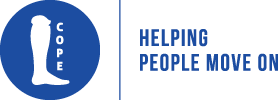PROSTHETICS AND ORTHOTICS
Since 1998, all the prosthetic and orthotic devices made in Laos use polypropylene technology. Polypropylene is a highly durable but low cost material, and is used extensively by the International Committee of the Red Cross in low-income environments.
With COPE support, prosthetic and orthotic services are delivered free of charge at the five Rehabilitation Centers throughout the country. A smaller range of services are also delivered by Mobile Clinics in rural and remote areas.
PROSTHETIC DEVICES
A prosthesis is a device that replaces a body part. Artificial limbs can improve mobility and the ability to manage daily activities, as well as provide the means to stay independent.
50% of the people who COPE assists with rehabilitation services require prostheses. People with prosthetic devices will need lifelong access to rehabilitation services. An adult’s prosthetic device needs to be replaced every two to seven years. For children, replacements are required more frequently every six months.
In Laos, two thirds of people needing prosthetic devices have experienced UXO and traffic accidents.
PROSTHETIC DEVICE USER PROFILES IN LAOS
UXO (UNEXPLODED ORDNANCE)
In 2012, UXO survivors in Laos were estimated at 15,000 people. Many of them are amputees requiring regular medical, rehabilitative, and social services over the course of their lifetime. One third of COPE’s prosthetic patients are UXO survivors.
TRAUMA INJURIES
The rate of trauma from accidents in on the rise in Laos, mainly due to the increasing number of traffic accidents, particularly amongst young people. Today, people involved in road traffic accidents account for one third of COPE prosthetic patients.
OTHERS
Other reasons include diabetes, leprosy, osteomyelitis, bone tumors, and congenital limb defects. Complications from infections can also lead to septicemia or gangrene which require amputation.
1/3 of prosthetics patients supported by COPE are UXO survivors
TYPES OF PROSTHESES
There is a wide range of prostheses available tailored to the specific needs of each individual. These include:
- Lower-limb prostheses:
- Partial foot prosthesis
- Through-ankle prosthesis
- Below knee prosthesis
- Through-knee prosthesis
- Above knee prosthesis
- Upper-limb prostheses:
- Through-wrist prosthesis
- Trans-radial prosthesis
- Trans-humeral prosthesis
ORTHOTIC AND ASSISTIVE DEVICES
An orthosis is an external device that can improve a person’s mobility and prevent further deformity by supporting, realigning, and/or correcting a weak body part.
50% of the people who COPE assists with rehabilitation services require orthotic or assistive devices (e.g. crutches, walking frames, wheelchairs with postural supports). Unlike prosthetic devices, some orthoses can be part of a short-term treatment, correcting an impairment for life (e.g., clubfoot treatment). Long-term orthotic devices need to be maintained and replaced throughout an individual’s lifetime (e.g. poliomyelitis).
ORTHOTIC DEVICE PRESCRIPTION
CLUBFOOT
In Laos, more than 2 children in every 100 under the age of five are born with clubfoot. Early detection and treatment is vital to ensure the best results and that children can partake in normal activities (such as school) with their peers. The Ponseti technique is a gradual correction of the deformity that, when done correctly, is painless, fast, and cost-effective. COPE introduced the technique to Laos in 2004, training staff in all five rehabilitation centres. It has been a successful procedure in children as old as 13.
In Laos, more than 2 children under five out of 100 are born with clubfoot; COPE is the only organization to support their treatment and prevent them from having their mobility impaired for life.
NEUROLOGICAL DISORDER DISABILITIES
With COPE’s support, the Rehabilitation Centres help people with various neurological disorder-induced disabilities such as cerebral palsy, stroke, spinal cord injuries or diseases, nerve paralysis and post poliomyelitis complications to access regular physiotherapy consultations, orthotics or braces, assistive devices, wheelchairs, etc.
OTHERS
Other reasons why a patient may be prescribed an orthotic device include muscle weakness, paralysis of nerve and muscles, bone deformities, joint deformities, contracture of skin or soft tissues around the joints, burn contractures, post-fracture abnormalities, lost limbs (amputations), and joint/muscle contracture.
TYPES OF ORTHOSES
There is a wide range of orthoses available, tailored to the specific needs of each individual. These include:
- Lower-limb orthoses:
- Foot orthosis
- Ankle foot orthosis
- Knee ankle foot orthosis
- Knee orthosis
- Hip knee ankle orthosis
- Trunk orthoses:
- Lumbosacral orthosis
- Thoracic lumbosacral orthosis
- Cervical orthosis
- Upper-limb orthosis:
- Wrist hand orthosis
JOURNEY THROUGH PHYSICAL REHABILITATION
- First point of contact (be it during a Mobile Clinic or at one of the five Rehabilitation Centers) with a team of health care providers to assess the needs of an individual.
- Patients are diagnosed and given a prescription for treatment.
- Patients with missing lower limbs receive one pair of elbow crutches. Some individuals will require stump revision surgery before a device can be properly fitted.
- The prosthetist or orthotist then proceeds to make a cast of the limb.
- Bench technicians then manufacture and assemble the device, using polypropylene technology. If needed, the physiotherapist provides rehabilitation training in preparation for the fitting of the device.
- The first device fitting with a patient is managed by a prosthetist/orthotist, a physiotherapist and a doctor.
- With the new device, the patient trains with a physiotherapist to check the device’s suitability. The bench technician will make any final readjustments of the device according to the patient needs.
- After the final fitting, the patient is discharged by the rehabilitation team, and given a follow-up appointment in the next 6-12 months.
